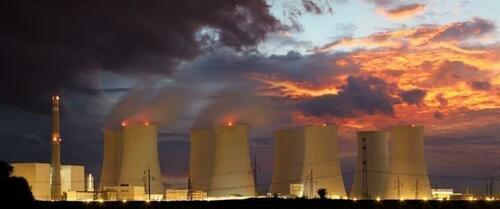
Google Bets Big On Nuclear Fusion
Authored by Felicity Bradstock via OilPrice.com,
-
Google signed the first direct corporate power purchase agreement for nuclear fusion energy with Commonwealth Fusion Systems.
-
The global race to achieve commercial nuclear fusion is intensifying, with significant investments from the U.S., China, and the European Union.
-
Nuclear fusion promises to deliver abundant, clean energy, potentially revolutionizing the global energy landscape and reducing reliance on fossil fuels.
For decades, researchers have been assessing the potential to develop nuclear fusion reactors, capable of producing abundant clean energy. However, despite several breakthroughs in recent years, most scientists agree that we are far from achieving the commercial rollout of this technology. Nevertheless, the barrier has not stopped widespread investment in the technology, the most recent of which came from U.S. tech giant Google.

According to the International Energy Agency (IEA) definition, Nuclear fusion is the process by which two light atomic nuclei combine to form a single heavier one while releasing massive amounts of energy. Fusion reactions take place in a state of matter called plasma – a hot, charged gas made of positive ions and free-moving electrons with unique properties distinct from solids, liquids, or gases…nuclei need to collide with each other at extremely high temperatures – around ten million degrees Celsius. When the nuclei come within a very close range of each other, the attractive nuclear force between them will outweigh the electrical repulsion and allow them to fuse. For this to happen, the nuclei must be confined within a small space to increase the chances of collision.
Nuclear fusion differs from nuclear fission, the current nuclear power production process used worldwide, which occurs when a neutron slams into a larger atom, forcing it to excite and split into two smaller atoms, also known as fission products. Additional neutrons are also released that can initiate a chain reaction. When each atom splits, a massive amount of energy is released. Uranium and plutonium are the most commonly used fuels for fission reactions.
After decades of investment and research into nuclear fusion around the globe, several breakthroughs have put us one step closer to achieving a nuclear fusion reaction that could lead to the commercial rollout of fusion reactors. As of 2025, commercial fusion companies have raised over $9 billion in investment, and many governments now view fusion as the modern-day 'space race’. Currently, there are around 50 private companies worldwide pursuing commercial fusion, and many are hopeful that the previous timeline of around 30 years for a commercial rollout may have been overexaggerated.
In May, a long-delayed nuclear fusion project, supported by over 30 countries, finally announced it was prepared to assemble the world’s most powerful magnet. The International Thermonuclear Experimental Reactor (ITER) project, based in southern France and supported by the United States, China, Japan, Russia, and the European Union, aims to create an “invisible cage” to contain super-hot plasma particles that combine and fuse to release energy. Following years of delays, the start-up phase of the project is now scheduled to begin in 2033, when it is expected to start generating plasma.
In addition to the joint project, some countries are battling to be the first to achieve commercial nuclear fusion. In February, satellite images emerged revealing a giant facility in China. The images showed a massive nuclear fusion research facility, which many have taken to mean that China is racing ahead in nuclear fusion development.
The Chinese government is spending between an estimated $1 billion to $1.5 billion annually in fusion research and development, according to the lead of the U.S. Department of Energy’s Office of Fusion Energy Sciences, Jean Paul Allain. Meanwhile, former President Biden was spending around $800 million a year, although the U.S. is also making significant progress in nuclear fusion.
In the U.S., Commonwealth Fusion Systems (CFS) engineers are developing a fusion project consisting of a doughnut-shaped machine known as a tokamak and called SPARC, which they hope will achieve a nuclear fusion reaction. CFS is a company that spun off from the Massachusetts Institute of Technology in 2018. The firm has raised over $2 billion in funding to develop the machine, although it is not certain how long it will take and whether it will be able to achieve a net surplus of energy once it is up and running. However, the company’s target is to construct the world’s first fusion-fuelled power plant in Virginia by the early 2030s.
This week, Alphabet, the parent company of Google, came to an agreement with CFS to purchase power from its nuclear fusion project. Google signed the technology’s first direct corporate power purchase agreement, according to the tech company. CFS CEO and co-founder Bob Mumgaard stated, “Without partnership and without being bold and setting a goal and going for it, you won’t ever reach over those challenges.” The financing forms part of a new funding round for CFS, after Google invested $1.8 billion into the firm during its previous 2021 round.
Several countries around the world are racing to develop nuclear fusion technology that can be rolled out at the commercial level to support clean energy development and a shift away from fossil fuels. Achieving this level of fusion reaction would allow governments to provide far more abundant clean power than they are currently able to supply through fission and renewable energy projects.
Tyler Durden
Mon, 07/07/2025 – 06:30


















